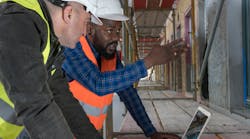On mid-sized and larger construction jobs, it's common for multiple trades from different subcontractors to be working different parts of the project in the same general space. Normally, the general contractor controls site safety rules, policies, and (to some extent) training and enforcement. Unfortunately, there's not time for a comprehensive six-week safety training course prior to starting the work. There is a general safety orientation, and normally each subcontractor takes over from there.
How safe a subcontractor's crew is will depend upon many factors, such as:
- Hiring practices. A firm that is more a “warm body” type will tend to hire less safety-conscious people than a firm that hires based on a specific fit. Individual attitudes matter enormously.
- Age and demographics. There's a reason why car rental firms typically will not rent to someone under 25. Below about that age, the brain hasn't yet developed its judgment center fully. So those under about age 25 are less risk-averse than people older than that.
- Work experience. Even older workers might not “get it” about construction site safety, if their work experience has been entirely in unrelated areas and they decided to try their hand at construction work. On the upside, they tend to close the gap rapidly.
- Company culture. If safety is a “check off the box” thing rather than a core principle in the company, expect poor safety training and poor safety attitudes.
- Crew culture. This is similar to company culture, but specific to that crew. Are they distracted, or do they focus on the work at hand and work methodically?
- Crew experience. If the crew hasn't worked along other trades much, this is likely going to be a problem. It's why you might see a pipefitter using a conduit bender or a sheetrock person walking on your portable cords.
Suppose your crew has been pulling cable all day, and it's now mid-afternoon. You have the area roped off with yellow tape. There's cable lube on the floor, though you have mostly kept it under control. You've got the cable under tension and are about ready to radio Bob to start this particular pull, when two laborers cross the tape. You watch, incredulous, as they walk directly to the cable and step over it. That's the third time today they've taken this shortcut through your area, and you spoke to them about it the other two times. What do you do now?
This situation happens with cranes too, and the solution most often used there is the signalman looks at the hard hat color and then asks someone nearby to go get a supervisor from that company. An electrical crew leader or supervisor can do something similar.
Since you've already spoken to these people twice, locate their supervisor. Then (if you are the supervisor of your crew) speak, supervisor to supervisor, about the problem. It is the (very) rare supervisor who won't take care of the problem.
If that doesn't work, your next step is to contact the general contractor's site safety supervisor or site superintendent. That should resolve it.
New supervisors often believe they can't speak to employees of other subcontractors about safety problems, but to the reality is everyone needs to work together to make a job site safe.




